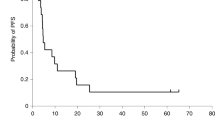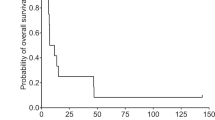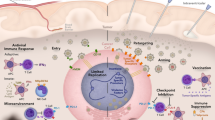Abstract
Replication-competent oncolytic herpes simplex viruses (HSV), modified by deletion of certain viral growth genes, can selectively target malignant cells. The viral growth gene γ134.5 has significant homology to GADD34 (growth arrest and DNA damage protein 34), which promotes cell cycle arrest and DNA repair in response to stressors such as radiation (XRT). By upregulating GADD34, XRT may result in greater oncolytic activity of HSV strains deficient in the γ134.5 gene. The human cholangiocarcinoma cell lines KMBC, SK-ChA-1 and YoMi were treated with NV1023, an oncolytic HSV lacking one copy of γ134.5. Viral proliferation assays were performed at a multiplicity of infection (MOI, number of viral particles per tumor cell) equal to 1, either alone or after XRT at 250 or 500 cGy. Viral replication was assessed by plaque assay. In vitro cytotoxicity assays were performed using virus at MOIs of 0.01 and 0.1, with or without XRT at 250 cGy and cell survival determined with lactate dehydrogenase assay. Established flank tumors in athymic mice were treated with a single intratumoral injection of virus (103 or 104 plaque forming units), either alone or after a single dose of XRT at 500 cGy, and tumor volumes measured. RT-PCR was used to measure GADD34 mRNA levels in all cell lines after a single dose of XRT at 250 or 500 cGy. NV1023 was tumoricidal in all three cell lines, but sensitivity to the virus varied. XRT enhanced viral replication in vitro in all cell lines. Combination treatment with low-dose XRT and virus was highly tumoricidal, both in vitro and in vivo. The greatest tumor volume reduction with combination therapy was seen with YoMi cells, the only cell line with increased GADD34 expression after XRT and the only cell line in which a synergistic treatment effect was suggested. In KMBC and SK-ChA-1 cells, neither of which showed increased GADD34 expression after XRT, tumor volume reduction was less pronounced and there was no suggestion of a synergistic effect in either case. Oncolytic HSV are effective in treating human cholangiocarcinoma cell lines, although sensitivity to virus varies. XRT-enhanced viral replication occurs through a mechanism that is not necessarily dependent on GADD34 upregulation. However, XRT-induced upregulation of GADD34 further promotes tumoricidal activity in viral strains deficient in the γ134.5 gene, resulting in treatment synergy; this effect is cell type dependent. Combined XRT and oncolytic viral therapy is a potentially important treatment strategy that may enhance the therapeutic ratios of both individual therapies.
This is a preview of subscription content, access via your institution
Access options
Subscribe to this journal
Receive 12 print issues and online access
$259.00 per year
only $21.58 per issue
Buy this article
- Purchase on Springer Link
- Instant access to full article PDF
Prices may be subject to local taxes which are calculated during checkout





Similar content being viewed by others
References
Bismuth H, Nakache R, Diamond T . Management strategies in resection for hilar cholangiocarcinoma. Ann Surg 1992; 215: 31–38.
Jarnagin WR, Fong Y, DeMatteo RP, Gonen M, Burke EC, Bodniewicz BJ et al. Staging, resectability, and outcome in 225 patients with hilar cholangiocarcinoma. Ann Surg 2001; 234: 507–517.
Gonzalez GD, Gerard JP, Maners AW, Lande-Guyaux B, Dijk-Milatz A, Meerwaldt JH et al. Results of radiation therapy in carcinoma of the proximal bile duct (Klatskin tumor). Semin Liver Dis 1990; 10: 131–141.
Kresl JJ, Schild SE, Henning GT, Gunderson LL, Donohue J, Pitot H et al. Adjuvant external beam radiation therapy with concurrent chemotherapy in the management of gallbladder carcinoma. Int J Rad Oncol Biol Phys 2002; 52: 167–175.
Macdonald OK . Palliative and postoperative radiotherapy in biliary tract cancer. Surg Oncol Clin N Am 2002; 11: 941–954.
Bennett JJ, Kooby D, Delman K, McAuliffe P, Halterman MW, Federoff H et al. Antitumor efficacy of regional oncolytic viral therapy for peritoneally disseminated cancer. J Mol Med 2002; 78: 166–174.
Kooby DA, Carew JF, Halterman MW, Mack JE, Bertino JR, Blumgart LH et al. Oncolytic viral therapy for human colorectal cancer and liver metastases using a multi-mutated herpes simplex virus type-1 (G207). FASEB J 1999; 13 (11): 1325–1334.
Mineta T, Rabkin SD, Yazaki T, Hunter WD, Martuza RL . Attenuated multi-mutated herpes simplex virus-1 for the treatment of malignant gliomas. Nat Med 1995; 1: 938–943.
Blank SV, Rubin SC, Coukos G, Amin KM, Albelda SM, Molnar-Kimber KL . Replication-selective herpes simplex virus type 1 mutant therapy of cervical cancer is enhanced by low-dose radiation. Hum Gene Ther 2002; 13: 627–639.
Chung SM, Advani SJ, Bradley JD, Kataok Y, Vashistha K, Yan SY et al. The use of a genetically engineered herpes simplex virus (R7020) with ionizing radiation for experimental hepatoma. Gene Therapy 2002; 9: 75–80.
Advani SJ, Sibley GS, Song PY, Hallahan DE, Kataoka Y, Roizman B et al. Enhancement of replication of genetically engineered herpes simplex viruses by ionizing radiation: a new paradigm for destruction of therapeutically intractable tumors. Gene Therapy 1998; 5: 160–165.
Hollander MC, Poola-Kella S, Fornace Jr AJ . Gadd34 functional domains involved in growth suppression and apoptosis. Oncogene 2003; 22: 3827–3832.
Hollander MC, Sheikh MS, Yu K, Zhan Q, Iglesias M, Woodworth C et al. Activation of Gadd34 by diverse apoptotic signals and suppression of its growth inhibitory effects by apoptotic inhibitors. Int J Cancer 2001; 96: 22–31.
Hollander MC, Zhan Q, Bae I, Fornace Jr AJ . Mammalian GADD34, an apoptosis- and DNA damage-inducible gene. J Biol Chem 1997; 272: 13731–13737.
He B, Gross M, Roizman B . The gamma(1)34.5 protein of herpes simplex virus 1 complexes with protein phosphatase 1alpha to dephosphorylate the alpha subunit of the eukaryotic translation initiation factor 2 and preclude the shutoff of protein synthesis by double-stranded RNA-activated protein kinase. Proc Natl Acad Sci USA 1997; 94: 843–848.
Yano H, Maruiwa M, Iemura A, Mizoguchi A, Kojiro M . Establishment and characterization of a new human extrahepatic bile duct carcinoma cell line (KMBC). Cancer 1992; 69: 1664–1673.
Knuth A, Gabbert H, Dippold W, Klein O, Sachsse W, Bitter-Suermann D et al. Biliary adenocarcinoma. Characterisation of three new human tumor cell lines. J Hepatol 1985; 1: 579–596.
Meignier B, Martin B, Whitley RJ, Roizman B . In vivo behavior of genetically engineered herpes simplex viruses R7017 and R7020. II. Studies in immunocompetent and immunosuppressed owl monkeys (Aotus trivirgatus). J Infect Dis 1990; 162: 313–321.
Meignier B, Longnecker R, Roizman B . In vivo behavior of genetically engineered herpes simplex viruses R7017 and R7020: construction and evaluation in rodents. J Infect Dis 1988; 158: 602–614.
Meignier B, Martin B, Whitley RJ, Roizman B . In vivo behavior of genetically engineered herpes simplex viruses R7017 and R7020. II. Studies in immunocompetent and immunosuppressed Owl monkeys (Aotus trivirgatus). J Infect Dis 1990; 162: 313–321.
Bennett JJ, Malhotra S, Wong RJ, Delman K, Zager J, St Louis M et al. Interleukin 12 secretion enhances antitumor efficacy of oncolytic herpes simplex viral therapy for colorectal cancer. Ann Surg 2002; 233: 819–826.
Wong RJ, Patel SG, Kim S, DeMatteo RP, Malhotra S, Bennett JJ et al. Cytokine gene transfer enhances herpes oncolytic therapy in murine squamous cell carcinoma. Hum Gene Ther 2001; 12: 253–265.
Jarnagin WR, Ruo L, Little SA, Klimstra D, D'Angelica M, DeMatteo RP et al. Patterns of initial disease recurrence after resection of gallbladder carcinoma and hilar cholangiocarcinoma: implications for adjuvant therapeutic strategies. Cancer 2003; 98: 1689–1700.
Stanziale SF, Petrowsky H, Joe JK, Roberts GD, Zager JS, Gusani NJ et al. Ionizing radiation potentiates the antitumor efficacy of oncolytic herpes simplex virus G207 by upregulating ribonucleotide reductase. Surgery 2002; 132: 353–359.
Fornace Jr AJ, Nebert DW, Hollander MC, Luethy JD, Papathanasiou M, Fargnoli J et al. Mammalian genes coordinately regulated by growth arrest signals and DNA-damaging agents. Mol Cell Biol 1989; 9: 4196–4203.
Fornace Jr AJ, Alamo Jr I, Hollander MC . DNA damage-inducible transcripts in mammalian cells. Proc Natl Acad Sci USA 1988; 85: 8800–8804.
Amundson SA, Myers TG, Scudiero D, Kitada S, Reed JC, Fornace Jr AJ . An informatics approach identifying markers of chemosensitivity in human cancer cell lines. Cancer Res 2000; 60: 6101–6110.
Fornace Jr AJ, Amundson SA, Bittner M, Myers TG, Meltzer P, Weinstein JN et al. The complexity of radiation stress responses: analysis by informatics and functional genomics approaches. [Review] [74 refs]. Gene Expr 1999; 7: 387–400.
Amundson SA, Zhan Q, Penn LZ, Fornace Jr AJ . Myc suppresses induction of the growth arrest genes gadd34, gadd45, and gadd153 by DNA-damaging agents. Oncogene 1998; 17: 2149–2154.
Acknowledgements
This work was supported in part by grants RO1 CA 75416, RO1 CA 72632 and RO1CA61524 (YF) from the National Institutes of Health and Grant MBC-99366 (YF) from the American Cancer Society.
Author information
Authors and Affiliations
Corresponding author
Rights and permissions
About this article
Cite this article
Jarnagin, W., Zager, J., Hezel, M. et al. Treatment of cholangiocarcinoma with oncolytic herpes simplex virus combined with external beam radiation therapy. Cancer Gene Ther 13, 326–334 (2006). https://doi.org/10.1038/sj.cgt.7700890
Received:
Revised:
Accepted:
Published:
Issue Date:
DOI: https://doi.org/10.1038/sj.cgt.7700890
Keywords
This article is cited by
-
Virotheranostics, a double-barreled viral gun pointed toward cancer; ready to shoot?
Cancer Cell International (2020)
-
In vitro detection of cholangiocarcinoma cells using a fluorescent protein-expressing oncolytic herpes virus
Cancer Gene Therapy (2017)
-
Recombinant vaccinia virus GLV-1h68 is a promising oncolytic vector in the treatment of cholangiocarcinoma
Cancer Gene Therapy (2015)
-
Advance in herpes simplex viruses for cancer therapy
Science China Life Sciences (2013)
-
Intelligent Design: Combination Therapy With Oncolytic Viruses
Molecular Therapy (2010)



